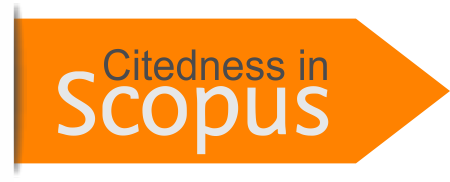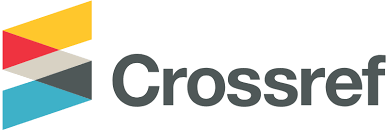Credibility of EWOM and Consumer Satisfaction on Food/Health Supplement Products during the COVID-19 Pandemic
Abstract
During the pandemic, many information about the function of various food and health supplement products for prevention/recovery from Covid-19 infection circulated through EWOM (electronic word of mouth), which was believed by consumers, even though not all of them were proven to be true. This study aims to examine the role of perceived EWOM credibility on consumer satisfaction with food/health supplement products during the COVID-19 pandemic. The theoretical framework guiding this research is Source Credibility Theory, which provides a lens to examine how the credibility of EWOM sources affects consumer satisfaction. The participants were 103 people aged 19-25 years who had purchased and consumed food/health supplement products during the COVID-19 pandemic and had read EWOM about information/reviews of the products they consumed. Participants filled out a questionnaire that measured their perceived EWOM credibility and consumer satisfaction. The data were analyzed using multiple linear regression. The results showed that perceived EWOM credibility positively influenced consumer satisfaction. Aspects of perceived EWOM credibility, included argument quality and homophily had a significant influence on consumer satisfaction. The quality of arguments positively contributes to enhancing customer satisfaction, whereas homophily, on the other hand, has a negative impact. Consequently, a heightened perception of EWOM credibility, particularly concerning the quality of argument presented directly correlated with increased participant satisfaction with the food/health supplement products they had consumed. The findings of this study hold practical implications for the promotion of food and health supplements, emphasizing the significance of EWOM credibility. Additionally, the results underscore the importance of fostering information literacy among consumers in this domain. For instance, strategies could include the dissemination of infographics illustrating methods to assess information quality and discern genuine information from hoaxes. On the other hand, relying solely on information based on shared backgrounds does not fully support the attainment of satisfaction in consumption.
Keywords
Full Text:
PDFReferences
Annur, C. M. (2020). KIC Research: Society assesses that political content mostly contains hoaxes & fake news. Databoks - Katadata.co.id. Retrieved from https://databoks.katadata.co.id/datapublish/2020/11/23/riset-kic- masyarakat- menilai-konten-politik-paling-banyak-mengandung- hoaks-berita-bohong
Bartram, D., Berberoglu, G., Grégoire, J., & Hambleton, R. K. (2017). ITC guidelines for translating and adapting tests (2nd ed.). International Journal of Testing, 18(2), 101-134. DOI: 10.1080/15305058.2017.1398166.
Basusena, Y. T. A., & Astiti, D. P. (2020). Word of mouth: Before, now, and later. Scientific Bulletin of Psychology, 1(3), 196 - 202. DOI: 10.24014/PIB.V1I3.9855.
Baur, T., & Nyström, B. (2017). The effect of eWOM components on brand attitude and purchase intention: A cross country study between Germany and Sweden. Luleå University of Technology: Bachelor of International Business Administration.
Bhattacherjee, A., & Sanford, C. (2006). Influence process for information technologyacceptance: an elaboration likelihood model. MIS Quarterly, 30(4), 805-825. DOI: 10.2307/25148755.
Bickart, B., & Schindler, R. M. (2001). Internet forums as influential sources of consumer information. Journal of Interactive Marketing, 153, 31-40. DOI:10.1002/dir.1014.
Biesok, G., & Wyród-Wróbel, J. (2011). Customer satisfaction — Meaning and methods of measuring. In: H. Howaniec, W. Waszkielewicz (ed.), Marketing and logistic problems in the management of organization (23 - 41). Bielsko-Biała: Wydawnictwo Naukowe Akademii Techniczno-Humanistycznej w Bielsku-Białej.
Brown, J., Broderick, A. J., & Lee, N. (2007). Word of mouth communication within online communities: Conceptualizing the online social network. Journal of Interactive Marketing, 21(3), 2- 20. DOI: 10.1002/dir.20082.
Burton, J., & Khammash, M. (2010). Why do people read reviews posted on customer opinion portals? Journal of Marketing Management, 26(3– 4), 230–255. DOI: 10.1080/02672570903566268.
Cacioppo, J. T., Petty, R. E., & Morris, K. J. (1983). Effects of need for cognition on message evaluation, recall, and persuasion. Journal of Personality and Social Psychology, 45, 805 - 818. DOI: 10.1037/0022-3514.45.4.805.
Cheung, C. M. K., & Thadani, D. R. (2010). The effectiveness of e-wom communication: A literature analysis. 23rd Bled E-conference.
Cheung, M. Y., Luo, C., Sia, C. L., & Chen, H. (2014). Credibility of electronic word-of-mouth: Informational and normative determinants of on-line consumer recommendations. International Journal of Electronic Commerce, 13(4), 9-38. DOI: 10.2753/JEC1086-4415130402.
Chih, W., Hsu, L., & Jaime, O. (2020). The antecedents and consequences of the perceived positive eWOM review credibility. Industrial Management & Data Systems, 120(6), 1217-1243. DOI: 10.1108/IMDS-10-2019-0573.
Chu, S. C., & Kim, Y. (2011). Determinants of consumer engagement in electronic word of mouth in social networking sites. International Journal of Advertising,30(1), 47-75. DOI: 10.2501/IJA-30-1-047- 075.
Daowd, A., Hasan, R., Eldabi, T., Rafi-Ul-Shan, P.M., Cao, D., & Kasemsarn, N. (2021). Factors affecting eWOM credibility, information adoption, and purchase intention on Generation Y: A case from Thailand. Journal of Enterprise Information Management, 34 (3). DOI: 10.1108/JEIM-04-2019-0118.
Dhini, V. A. (2021). Indonesian society consumes the most vitamin C during the Covid-19 pandemic. Databoks - Katadata.co.id. Retrieved from https://databoks.katadata.co.id/datapublish/2021/09/22/masyarakat- indonesia-paling-banyak-konsumsi-vitamin-c-saat-pandemi-covid- 19
Direktorate General of Drug and Food Control (1996). Decisions letter of the Directorate General of Drug and Food Control, Ministry of Health of the Republic of Indonesia. Indonesia: Jakarta.
Fogg, B. J., Kameda, T., Boyd, J., Marshall, J., Sethi, R., Sockol, M., and Trowbridge, T. (2002). Stanford makovsky web credibility study 2002: Investigating what makes web sites credible today. A Research Report by the Stanford Persuasive Technology Lab & Makovsky & Company. California: Stanford University.
Goldbeck, J. (2009). Trust and nuanced profile similarity in online social networks. ACM Transactions on the Web, 3, 12.
Gunawan, B., & Ratmono. B. M. (2018). Deception in the virtual world: Understanding its theories and practices in Indonesia. Jakarta: Gramedia.
Guilford, J. P. (1973). Fundamental statistics in psychology and education. New York: McGraw-Hill Book Co. Inc.
Hamdani, N. A., & Maulani, G. A. F. (2018). The influence of eWOM on purchase intentions in local culinary business sector. International Journal of Engineering & Technology, 7, 246-250. DOI: 10.14419/ijet.v7i2.29.13325.
Hennig-Thurau, T., Gwinner, K. P., Walsh, G., & Gremler, D. D. (2004). Electronic word-of-mouth via consumer opinion platforms: What motivates consumers to articulate themselves on the Internet? Journal of Interactive Marketing, 18(1), 38–52. DOI: 10.1002/dir.10073.
Harrison, P., & Shaw, R. (2004). Consumer satisfaction and post-purchase intentions: An exploratory study of museum visitors. International Journal of Arts Management, 6(2), 23-32.
Huang, J. H., & Chen, Y. F. (2006). Herding in online product choice.Psychology &Marketing, 23(5), 413-428. DOI: 10.1002/mar.20119.
Huete-Alcocer, N. (2017). A literature review of word of mouth and electronic word of mouth: Implications for consumer behavior. Frontiers in Psychology, 8. DOI: 10.3389/fpsyg.2017.01256.
Hyun, S., & Kim, I. (2014). Identifying optimal rapport-building behaviors in inducing patrons' emotional attachment in luxury restaurants. Journal of Hospitality and Tourism Research, 38, 162-198. DOI: 10.1177/1096348012451458.
Kuo, H-C., & Nakhata, C. (2019). The impact of electronic word of mouth on customer satisfaction. Journal of Marketing Theory and Practice, 27(3), 331- 348. DOI: 10.1080/10696679.2019.1615840.
Lis, B. (2013). In eWOM we trust: A framework of factors that determine the eWOM credibility. Business & Information Systems Engineering, 5(3), 129-140. DOI:10.1007/s12599-013-0261-9.
López-García, X., Costa-Sánchez, C., & Vizoso, Á. (2021). Journalistic fact-checking of information in pandemic: Stakeholders, hoaxes, and strategies to fight disinformation during the COVID-19 crisis in spain. International Journal of Environmental Research and Public Health, 18(3), 1227. DOI 10.3390/ijerph18031227.
Mansourimoayyed, F., Colabi, A. M., Hoseini, H. K., & Binesh, H. (2020). Factors affecting e-satisfaction and repurchase intention: The role of eWOM and personality. Journal of Critical Reviews, 7(1), 1126-1133. DOI: 10.31838/jcr.07.01.186.
Martawilaga, A. I., & Purwanegara, M. S. (2016). Information acceptance of electronic words of mouth (eWOM) and purchase intention through haul videos youtube. Journal of Business and Management, 5(5), 651- 660.
McKnight, D. H., & Kacmar, C. J. (2006). Factors of information credibility for an internet advice site. Proceedings of the 39th Annual Hawaii International Conference on System Sciences, 6, 113b. Los Alamitos, CA: IEEE Computer Society Press.
Mishra, A., & Satish, S. M. (2016). EWOM: Extant research review and future research avenues. The Journal for Decision Makers, 41(3), 222- 233. DOI: 10.1177/0256090916650952.
Newman, N., Fletcher, R., Schulz., A., Andi, S., Robertson, C. T., Nielsen, R. K. (2021). Reuters institute digital news report 2021 (10th ed.). Reuters Institute: University of Oxford.
Ngarmwongnoi, C., Oliveira, J., Abedrabbo, M., & Sahar, M. (2020). The implications of eWOM adoption on the customer journey. Journal of Consumer Marketing, 37(7). DOI: 10.1108/JCM-10-2019-3450.
Oliver, R. L. (2015). Satisfaction: A behavioral perspective on the consumer (2nd ed.). New York: Routledge.
Piedmont, R. L. (2014). Inter-item correlations. In Encyclopedia of Quality of Life and Well-Being Research, 3303-3304. Netherlands: Springer.
Pornpitakpan, C. (2004). The persuasiveness of source credibility: A critical review of five decades’ evidence. Journal of Applied Social Psychology, 34(2), 243-281. DOI: 10.1111/j.1559- 1816.2004.tb02547.x.
Putri, G. S. (2018, January 31). Science explains why we can trust or distrust strangers. Kompas.com. Retrieved from https://sains.kompas.com/read/2018/01/31/130600923/sains-jelaskan- mengapa- kita-bisa-percaya-atau-tidak-pada-orang-asing
Robin, S.P., & Judge, T.A (2022). Organizational Behaviour. (updated 18th edition. Global edition). England: Pearson Education Limited.
Rohmani, S. A. (2020). Implications of COVID-19 for efforts to fulfill food needs. Bulletin of Agricultural Development Planning, 1(2).
Solomon, M. R., Bamossy, G. J., Askegaard, S. T., & Hogg, M. K. (2016).Consumer behaviour: A European perspective (6th ed.). United Kingdom: Pearson.
Thurau, T.H., Gwinner, K.P., Walsh, G., & Gremler, D.D. (2004). Electronic word-of-mouth via consumer opinion platforms: What motivates consumers to articulate themselves on the Internet? Journal of Interactive Marketing, 18 (1), 38-52. DOI: 10.1002/dir.10073.
Wang, Z., Walther, J. B., Pingree, S., & Hawkins, R. P. (2008). Health information, credibility, homophily, and influence via the internet: Web sites versus discussion groups. Health Communication, 23, 4, 358-368. DOI: 10.1080/10410230802229738.
Wisnubroto, K. (2021). Digital literacy rolling out across the country. Portal Information Indonesia - Indonesia.go.id. Retrieved from https://www.indonesia.go.id/kategori/feature/2805/literasi-digital- bergulir-ke-seluruh-negeri
DOI: https://doi.org/10.46336/ijbesd.v5i1.577
Refbacks
- There are currently no refbacks.
Copyright (c) 2024 International Journal of Business, Economics, and Social Development

This work is licensed under a Creative Commons Attribution 4.0 International License.
Published By:
IJBESD: Jalan Riung Ampuh No. 3, Riung Bandung, Kota Bandung 40295, Jawa Barat, Indonesia
IJBESD Indexed By:
 This work is licensed under a Creative Commons Attribution 4.0 International License.
This work is licensed under a Creative Commons Attribution 4.0 International License.







.png)



